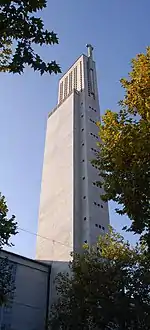Karl Moser (August 10, 1860 – February 28, 1936) was an architect from Switzerland.
-Portrait-Portr_00350.tif.jpg.webp)

Between 1887 and 1915 he worked together with Robert Curjel in Karlsruhe, setting up the architecture firm Curjel and Moser. Some of their works are:
- Kunsthaus Zurich
- University of Zurich
- Basel Badischer Bahnhof
- St. Paul's Church, Bern
- St. Anthony's (Antoniuskirche), Basel
- several Protestant churches
From 1915 to 1928 he was professor at ETH Zurich.
In 1928 he was president of the newly founded Congrès International d'Architecture Moderne, an organisation, steered prominently by the pioneers of modernism, architects Le Corbusier and Walter Gropius, which championed rational and functionalist architecture, while critiquing the type of revivalist architecture typified by Moser's own work. Indeed, at was at this time that Moser's own work changed radically towards modernism, exemplified in the St. Anthony's (Antoniuskirche) in Basel (1925–27), built in reinforced concrete rather than brick and stone typical for his earlier works.
His son Werner M. Moser also became a notable architect.
References
- Leonardo Benevolo. History of Modern Architecture, Volume 2. MIT Press, 1977 pg. 618